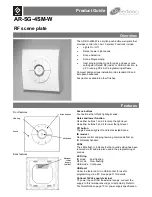
52
User’s Manual U12697EJ3V0UM
CHAPTER 2 PIN FUNCTIONS
(11) AV
REF1
This is the reference power input pin of the D/A converter.
If the D/A converter is not used, connect to the V
DD0
pin.
(12) AV
DD
This is the analog power supply pin of the A/D converter. Even if the A/D converter is not used, always use this
pin at the same potential as the V
DD0
pin. AV
DD
functions alternately as the reference voltage input pin of the
A/D converter.
(13) AV
SS
This is the ground potential pin of the A/D converter. Even if the A/D converter is not used, always use this pin
at the same potential as the V
SS0
pin.
(14) RESET
This is the active low system reset input pin.
(15) X1, X2
These are the crystal resonator connection pins for main system clock oscillation.
When an external clock is supplied, input this clock signal at X1, and its inverted signal at X2.
(16) XT1, XT2
These are the crystal resonator connection pins for subsystem clock oscillation.
When an external clock is supplied, input this clock signal at XT1, and its inverted signal at XT2.
(17) V
DD0
, V
DD1
V
DD0
is the positive power supply pin for the ports.
V
DD1
is the positive power supply pin for other than the ports and analog pins.
Always use this pin at the same potential as pin V
DD0
and V
DD1
.
(18) V
SS0
, V
SS1
V
SS0
is the ground potential pin for the ports.
V
SS1
is the ground potential pin for other than the ports and analog pins.
Always use this pin at the same potential as pin V
SS0
and V
SS1
.
(19) V
PP
(
µ
PD78F4225, 78F4225Y only)
This is the high-voltage application pin when setting the flash memory programming mode and writing or verifying
the program.
In the normal operation mode, connect directly to V
SS0
or pull down.
For the pull-down connection, use of a resistor with a resistance between 470
Ω
and 10 k
Ω
is recommended.
(20) TEST
This is the pin used in the IC test. Connect directly to V
SS0
or pull down.
For the pull-down connection, use of a resistor with a resistance between 470
Ω
and 10 k
Ω
is recommended.
















































